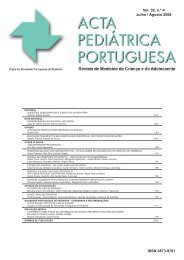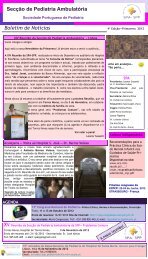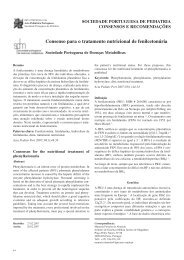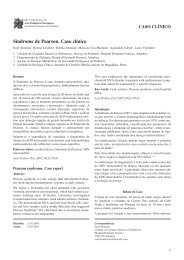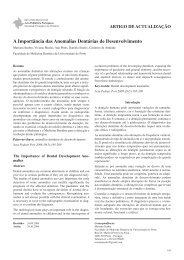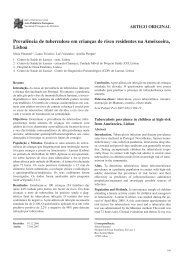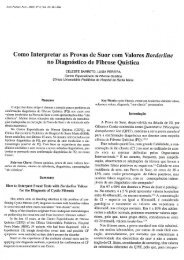Acta Ped Vol 42 N 3 - Sociedade Portuguesa de Pediatria
Acta Ped Vol 42 N 3 - Sociedade Portuguesa de Pediatria
Acta Ped Vol 42 N 3 - Sociedade Portuguesa de Pediatria
Create successful ePaper yourself
Turn your PDF publications into a flip-book with our unique Google optimized e-Paper software.
<strong>Acta</strong> <strong>Ped</strong>iatr Port 2011:<strong>42</strong>(3):117-22<br />
Zonta MB et al. – Conduta na hemiplegia espástica<br />
planos terapêuticos individualmente. A autora muito provavelmente<br />
estava enfatizando a habilida<strong>de</strong> clínica em avaliar<br />
toda a constelação <strong>de</strong> alterações presentes na síndrome do<br />
neurônio motor superior. Só a partir disto é possível selecionar<br />
estratégias para cada uma das alterações e propiciar o<br />
alcance <strong>de</strong> metas reais <strong>de</strong> reabilitação. Muitos indivíduos com<br />
PCHE serão beneficiados pelo fortalecimento muscular,<br />
treino funcional, estimulação neuro-sensorial e cognitiva,<br />
concomitantemente a abordagem da espasticida<strong>de</strong>. O objetivo<br />
<strong>de</strong> qualquer tratamento para crianças com PCHE é melhorar<br />
sua função e proporcionar in<strong>de</strong>pendência, ajudando-as a<br />
<strong>de</strong>senvolver seu potencial <strong>de</strong>ntro <strong>de</strong> um padrão o mais próximo<br />
possível do normal. Para isto é necessária uma visão<br />
maior da incapacida<strong>de</strong>, que consi<strong>de</strong>re não apenas a influência<br />
dos componentes positivos e negativos resultantes da lesão do<br />
primeiro neurônio, mas também a condição <strong>de</strong> atenção, percepção,<br />
adaptação da criança ao seu déficit e a<strong>de</strong>rência da<br />
família ao tratamento 63 .<br />
Referências<br />
1. Msall ME, Park JJ. Neuro<strong>de</strong>velopmental management strategies for<br />
children with cerebral palsy: optimizing function, promoting participation,<br />
and supporting families. Clin Obstet Gynecol 2008; 51:800-15.<br />
2. Tilton AH. Management of spasticity in children with cerebral palsy.<br />
Semin <strong>Ped</strong>iatr Neurol 2004; 11:58-65.<br />
3. Deluca SC, Echols K, Law CR, Ramey SL. Intensive pediatric constraint-induced<br />
therapy for children with cerebral palsy: randomized,<br />
controlled, crossover trial. J Child Neurol 2006; 21:931-8.<br />
4. Boyd RN, Morris ME, Grahan HK. Management of upper limb dysfunction<br />
in children with cerebral palsy: a systematic review. Eur J<br />
Neurol 2001;8: 150-66.<br />
5. Eliasson AC, Krumlin<strong>de</strong>-Sundholm L, Shaw K, Wang C. Effects of<br />
constraint-induced movement therapy in young children with hemiplegic<br />
cerebral palsy: an adapted mo<strong>de</strong>l. Dev Med Child Neurol 2005;<br />
47:266-75.<br />
6. Kong E. Early <strong>de</strong>tection of cerebral motor disor<strong>de</strong>rs. Med Sport Sci<br />
1992; 36:80-5.<br />
7. Bobath, K. A neuro-<strong>de</strong>velopmental treatment of cerebral palsy.<br />
Physiotherapy Aug 1963:2<strong>42</strong>-4.<br />
8. Bobath K, Bobath B. Tipos <strong>de</strong> paralisia cerebral. In: Tipos <strong>de</strong> paralisia<br />
cerebral. O <strong>de</strong>senvolvimento motor nos diferentes tipos <strong>de</strong> paralisia<br />
cerebral.. Manole Ed. 1989. São Paulo: 71-91.<br />
9. Kurtz LA, Scull AS. Rehabilitation for <strong>de</strong>velopmental disabilities.<br />
<strong>Ped</strong>iatr Clin North Am 1993; 40:629-43.<br />
10. Mayston MJ. Motor learning now needs meaningful goals. Letters. British<br />
Association of Bobath Trained Therapists. Produced by S.J. Denton<br />
Typesetting, Hallow, Worcestershire. Newsletter No. 38, Spring, 2001.<br />
11. Bower E, McLellan DL. Effect of increased exposure to physiotherapy<br />
on skill acquisition of children with cerebral palsy. Dev Med<br />
Child Neurol 1992; 34:25-39.<br />
12. Rotta NT. Paralisia cerebral, novas perspectivas terapêuticas. J<br />
<strong>Ped</strong>iatria 2002; 78 Suppl 1: S48-S54.<br />
13. Kanda T, Pidcock F, Hayakawa K, Yamori Y, Shikata Y. Motor outcome<br />
differences between two groups of children with spastic diplegia<br />
who received different intensities of early onset physiotherapy<br />
followed for 5 years. Brain & Dev 2004; 26:118-26.<br />
14. Krigger KW. Cerebral palsy: An overview. Am Family Phys 2006;<br />
73:91-100.<br />
15. Ahl LE, Johansson E, Carlberg EB. Functional therapy for children<br />
with cerebral palsy: an ecological approach. Dev Med Child Neurol<br />
2005; 47:613-19.<br />
16. Ungerlei<strong>de</strong>r LG, Doyon J, Karni A. Imaging brain plasticity during<br />
motor skill learning. Neurobiol Learn Mem 2002;78:553-64.<br />
17. Wolpaw JR, Carp JS. Plasticity from muscle to brain. Progr Neurobiol<br />
2006; 78:233-63.<br />
18. Chen Y, Chen XY, Jakeman LB, Schalk G, Stokes BT, Wolpaw JR.<br />
The interaction of a new motor skill and an old one: H-reflex conditioning<br />
and locomotion in rats. J Neurosc 2005; 29 :6898-906.<br />
19. Jang SH, Kim YH, Cho SH, Lee JH, Park JW, Know YH. Cortical<br />
reorganization induced by task-oriented training in chronic hemiplegic<br />
stroke patients. NeuroReport 2003; 14:137-41.<br />
20. Jang SH, Kim YH, Chang Y, Han BS, Byun WM, Chang CH. The predictive<br />
value of cortical activation by passive movement for motor<br />
recovery in stroke patients. Restorative Neurol Neurosc 2004; 22:59-63.<br />
21. Levy CE, Nichols DR, Schmalbrock PM, Chakeres DW. Functional<br />
MRI evi<strong>de</strong>nce of cortical reorganization in upper-limb stroke hemiparesis<br />
treated with constraint-induced movement therapy. Am J Phys<br />
Med Rehabilit 2001; 80:4-12.<br />
22. Merians AS, Jack D, Boian R, Tremaine M, Bur<strong>de</strong>a GC, Adamovich<br />
SV et al. Phys Ther 2002; 82:898-915.<br />
23. You SH, Jang SH, Kim YH, Know YH, Barrow I, Hallett M. Cortical<br />
reorganization induced by virtual reality therapy in a child with<br />
hemiparetic cerebral palsy. Dev Med Child Neurol 2005; 47:628-35.<br />
24. You SH, Sung HJ, Kim YH, Hallett M, Ahn SH, Know YH et al.<br />
Virtual reality-induced cortical reorganization and associated locomotor<br />
recovery in chronic stroke. An experimenter-blind randomized<br />
study. Stroke 2005;36:1166-71.<br />
25. Gordon, AM, Schnei<strong>de</strong>r JA, Chiinnam A, Charles JR. Efficacy of a<br />
hand-arm bimanual intensive therapy (HABIT) in children with<br />
hemiplegic cerebral palsy: a randomized control trial. Dev Med Child<br />
Neurol 2007; 49:830-38.<br />
26. Luft AR, Walter SM, Whitall J, Forrester LW, Macko R, Sorkin JD et al.<br />
Repetitive bilateral arm training and motor cortex activation in chronic<br />
stroke. A randomized controlled trial. JAMA 2004; 292:1853-61.<br />
27. Flett PJ, Stern LM, Waddy H, Connell TM, Seeger JD, Gibson SK.<br />
Botulinum toxin A versus fixed cast stretching for dynamic calf tightness<br />
in cerebral palsy. J Paediatr Child Health 1999; 35:71-7.<br />
28. Corry IS, Cosgrove AP, Duffy CM, Mcneill S, Taylor TC, Graham<br />
HK. Botulinum Toxin A compared with stretching casts in the treatment<br />
of spastic equinus: a randomized prospective trial. J <strong>Ped</strong>iatr<br />
Orthop 1998; 18:304-11.<br />
29. Law M, Cadman D, Rosenbaum P, Walter S, Russell D, De Mateo C.<br />
Neuro<strong>de</strong>velopmental therapy and upper-extremity inhibitive casting for<br />
children with cerebral palsy. Dev Med Child Neurol 1991; 33:379-87.<br />
30. Tardieu G, Tardieu C, Colbeau-Justin P, Lespargot A. Muscle<br />
hypoextensibility in children with cerebral palsy II: therapeutic<br />
implications. Arch Phys Med Rehabil 1982; 63:103-7.<br />
31. Gossman MR, Sahrmann SA, Rose SJ. Review of length-associated<br />
changes in muscle. Phys Ther 1982; 62:1799-808.<br />
32. Watt JM, Sims D, Harckham F, Schmidt L, Mcmillan A, Hamilton J.<br />
Prospecitive study of inhibitive castings as an adjunct to physiotherapy<br />
for cereberal-palsied children. Dev Med Child Neurol 1986;<br />
28:480-8.<br />
33. Bottos M, Bene<strong>de</strong>tti MG, Salucci P, Gasparroni V, Giannini S.<br />
Botulinum toxin with and without casting in ambulant children with<br />
spastic diplegia: a clinical and functional assessment. Dev Med Child<br />
Neurol 2003; 45:758-62.<br />
34. Morris C. A review of the efficacy of lower-limb orthoses used for<br />
cerebral palsy. Dev Med Child Neurol 2002; 44:205-11.<br />
121



